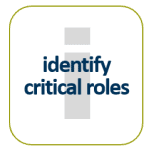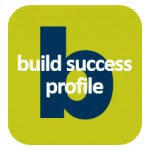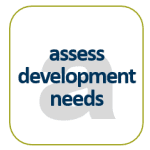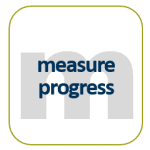How to Build Strong Success Profiles
Building Success Profiles to Understand Your Organization’s Needs
If you ask a dozen people what the key for success in a leadership role is, you’ll receive a dozen different answers. Every leader has their own style, and every role comes with its own set of requirements. The unexpected loss of a leader, due to personnel changes or retirement, can create a gap that is hard to fill, even if a company believes they are well prepared. This difficulty grows exponentially if a company is unclear on the characteristics that made that leader so successful in their role.
Build Success Profiles with the SIGMA Success Profile™ Template
The SIGMA Success Profile™ template is a worksheet designed to describe the leadership talent needed for success in a critical role as part of the succession planning process. The goal of this worksheet is to outline the knowledge, skills, abilities, and competencies needed for this role, both now and in the future. Success profiles provide leaders with a clear, comprehensive list of the requirements of a role, and can act as a benchmark against which to evaluate succession candidates. This creates a more simplified and standardized selection process. The SIGMA Success Profile™ template is best used following the identification of high-impact roles within the organization. Use our Critical Role Identification Worksheet to help with this process. Once you have identified the critical roles in your organization you are ready to move on and create success profiles. Begin by downloading the SIGMA Success Profile™ template.
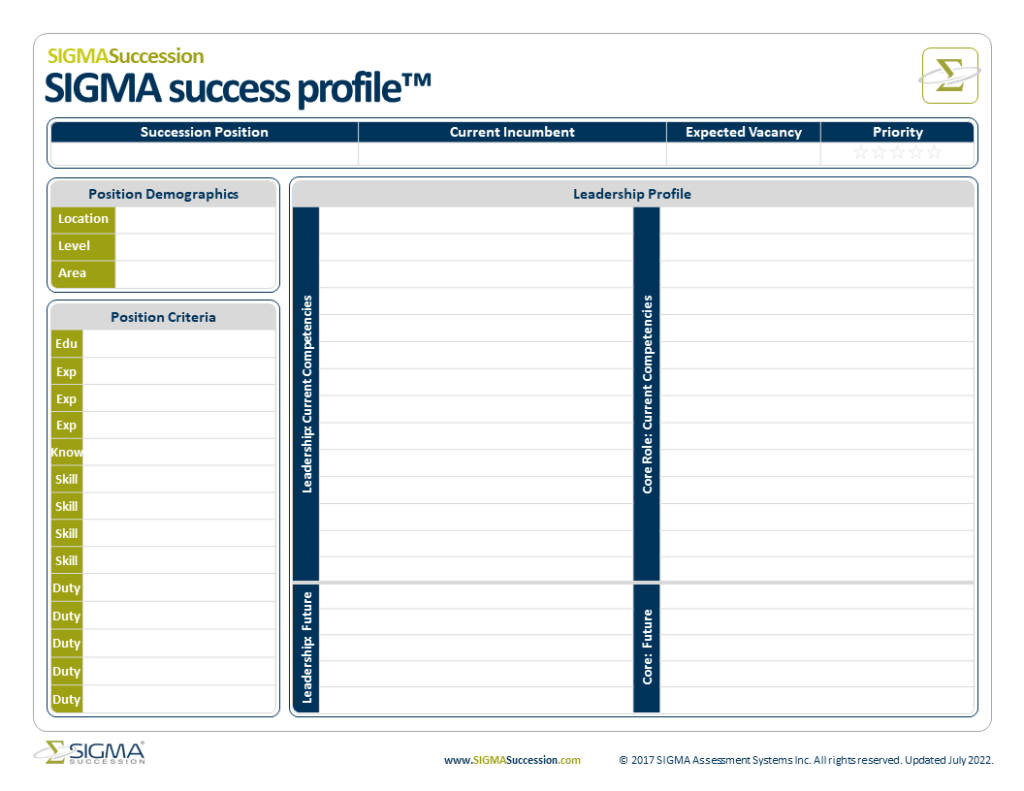
What is a Success Profile?
A success profile consists of the knowledge, skills, experiences, and characteristics that are required for success in any given role. It sets the standard for training and development, while also helping leaders evaluate who might make a good succession candidate for a position.
Now that we’ve really narrowed down our needs into one specific role, the most important or the most critical role at this point, the one that makes most sense to succession plan for, now we can really drill down and understand what’s important for that specific role, and what we call that is our succession…or our success profile. And in building that success profile, it should capture requirements of the position both today and more importantly, the future.
Critical Pieces of Building Success Profiles
The critical pieces here are, imagine the individual in this role has probably been there 15, 20, 25 years. It’s very difficult to separate Joe Smith from CFO. But it’s really important when we’re building the success profile to think of the role, the position all by itself separate from Joe. And as you can imagine, if you think of an individual like this at your organization, when individuals have been in a role for a long time, a lot of times their role will bleed into other areas of the organization. That’s not necessarily a bad thing, but when we’re building requirements for the role, think of the role by itself.
Gather Input
In generating this information, we need to gather input from a variety of sources. Certainly, the current incumbent is a really great resource. They’ve been doing the role for a significant length of time. That can both be a positive and a negative. The positive part is obviously they know the role of the role better than anyone else. The negative is they base their knowledge of the role on what they’ve been doing for the last 20 to 25 years. What we want to do is we want to build the success profile for what’s needed in the future so you can see that the incumbent’s perspective can only be one perspective in this process. A really great resource that’s sometimes not used are that individual’s direct reports. A lot of times they certainly have a great perspective and knowledge about what that role does because they’ve been working for that individual for several years and they also have a little bit different perspective and an eye towards the future. So, I think collectively if we gather the information from our incumbent, their direct reports and essentially the executive management team would consolidate that data together and come up with really the best fit for what that success profile looks like.
Organization Strategy
And finally, the one really critical piece that weaves through this success profile is your organization strategy. If we’re building a success profile for the future, we need to know where the organization is going to go in the future. So for example, if your organization is planning for really aggressive growth over the next 3 to 5 years, you can imagine that what a chief marketing officer does today for a company of 50 employees is going to be very, very different if our company is going to be 500 employees 5 years from now. So, that strategy piece is a really critical piece as we’re building the success profile.
Building the Success Profile
Building the success profile itself, in terms of the steps, it’s a relatively simple process. What we want to do from a pure logistics standpoint is for each success profile we’d want the position, the individual in the position, their planned exit year if we know, and it’s actually a great excuse to have the conversation with the incumbent if you haven’t already, and the urgency of which is obviously closely…really closely related to that exit date. We want to list the position requirements, and from a position criteria standpoint, it’s best if we have a job description that we can at least use as a baseline. And, you know, certainly, that may or may not be outdated. It will act as a baseline. And then we would gather input on from both the incumbent and their direct reports in terms of what would be needed for the future. And finally, again, just as a reminder, and I probably sound like a little bit of a broken record, but it’s really critical to always remind yourself, are we thinking of the person? Are we thinking of the role? For example, your CFO obviously needs an accounting designation, maybe 15 plus years in finance, etc., that’s the relatively easy part. But we all know that leadership is clearly determined by a variety of factors, including things like competency, character and emotional intelligence that you’ve probably heard a lot more of within the last few years. Scientifically validated assessments, which is a core part of our business at SIGMA are an excellent way to measure current talent and actually inform discussions about what’s important for the future. We’ve talked about gathering information from the incumbent, from their direct reports, certainly from the senior management team, but assessments can really close that loop and really add a lot of objective data to the process.
And finally, the key piece here is we’ve developed our success profile. We have a lot of really great information and essentially this is the target. This is what we’re shooting for as we develop successors into this role. But remember, this is not a static document. This is going to change maybe even on a year to year basis. We recommend, once you develop the document, actually put in your calendar at least on an annual basis to review and challenge the assumptions in that document.
Benefits of Building Success Profiles
Success profiles are immensely valuable tools that offer a clear understanding of the specific responsibilities and requirements associated with each critical role. Success profiles can be used to:
- Align job requirements with true indicators of success.
- Select and hire employees who are a good fit for each role.
- Establish role clarity.
- Create effective onboarding programs.
- Draft targeted employee development programs.
- Conduct objective, effective performance reviews.
- Troubleshoot areas where knowledge, skills, experiences, or competencies need development.
Why Success Profiles Matter
A good succession plan always begins by identifying the most critical roles in your organization. This creates a starting-point for your succession planning process. Once you are clear on who would have the most impact on your organization if they left tomorrow, you can begin to understand what each critical role entails, and what a successor would need in order to flourish in that position. Having strong success profiles for each critical role in your organization is important because success profiles allow leaders to:
- Nominate succession candidates who show potential for the role.
- Identify gaps between candidates’ current competencies, and what is required for success.
- Create targeted development plans that are tailored to the needs of each succession candidate.
- Measure progress in candidate development against a standardized benchmark for success.
- Select the best suited candidate for succession using objective criteria for success.
How to Use Success Profiles
The purpose of success profiles can extend beyond succession planning and can benefit many aspects of your organization. By developing success profiles for key positions in your company you will improve HR, talent management, and business development ventures. Practices that can benefit from comprehensive success profiling are:
- Hiring and recruitment
- Onboarding and talent development
- Leadership development
What Information is Needed for Building Success Profiles?
Before you begin building success profiles ensure that you have the required information – or means of obtaining the required information – about what is necessary for success in each critical role. Consider:
- Educational experience
- Work experience
- Technical and professional knowledge
- Personality and behavioural traits
- Talents, aptitudes, and intellectual capacities
- Leadership skills
How to Build a Success Profile
SIGMA has created a success profile template that allows you to fully explore the knowledge, skills, experiences, and characteristics that are required for success in any given role. This comprehensive template was designed to help you gather and document all the information about a critical role in one place, and to assist you in evaluating who might make good succession candidates for that position. It also sets the standard for training and development for these candidates.
1. Start with Demographics
Begin with basic demographic information. Use the results from the Critical Role Identification Questionnaire to indicate eligible exit year and urgency. Next, list important role information, such as location, level, and number of direct reports.
2. List Position Criteria
Use the job description for this role to list the position criteria, including:
- Necessary education
- Required experience
- Valuable skills
- Role duties
- Responsibilities
3. List Current Competencies Required for the Role
Using input from the Succession Advisory Team (SAT), incumbent, and those who come in contact with the critical role, list the current personal characteristics and competencies required for the job. This may include factors such as personality, ability, disposition, and skills.
Note: SIGMA’s success profile template has a column for leadership competencies and role-specific competencies. In the “Leadership” competency column, list skills and abilities that are required for all leaders in your organization. Think of common characteristics you would look for when hiring into senior management positions. In the “Core Role” competency column, list those skills and abilities that are unique to the critical role.
A Note on Incorporating Talent Assessments
When creating success profiles, it is important that individuals are drawing from a standardized list of skills and abilities. This standardized list is called a competency framework. Using a competency framework will ensure that everyone in your organization is using the same terms to describe skills and abilities. Using a competency framework also allows organizations to leverage talent assessments in later stages of the succession planning process. The benefits of these are significant. A valid and reliable talent assessment enables leaders to:
- Objectively assess candidates’ skills and abilities.
- Remove biases from the decision-making process.
- Standardize measurements across candidates.
- Reliably assess changes over time.
- Save time and money on developing an internal assessment strategy.
Using talent assessments can increase both the efficacy and efficiency of the succession planning process. We strongly recommend leaders consider incorporating talent assessments at this stage in the succession planning process, so that the competency framework can be used to create success profiles. This will allow for easier comparison between candidates’ results and requirements for success later on. If you are interested in using a scientifically validated assessment in your succession planning process, take a look at SIGMA’s flagship leadership assessment, the Leadership Skills Profile – Revised™ (LSP-R).
4. Consider Future Competencies
In addition to current competencies, consider future requirements for leaders in your organization, and for individuals looking to step into the critical role. Think about characteristics needed to stay current with industry trends, or any traits best suited for the future of the organization. Align these competencies with strategic planning where possible, and record them at the bottom of the SIGMA Success Profile template.
5. Review Success Profiles
Once you have completed the success profile template your organization should have a clearer understanding of the requirements for success in each critical role. Before moving on in the succession planning process, take a step back to review your success profiles and ensure this is the case. Once you are ready to move on, the next step in the succession process is to nominate successors for each critical role.

Tips for Building Strong Success Profiles
1. Success Profiles should be built for positions, not people
It can be easy to confound a role with the person currently occupying it. When building success profiles, be sure to focus on the position rather than the incumbent. Ask yourself what skills and abilities are required for success in that role, rather than what skills and abilities the incumbent currently has. This is your chance for a fresh look at the position. Consider the job requirements, tasks, and expectations for this role. What skills or experiences are needed in order to satisfy those requirements? What traits or characteristics would help a person excel at those tasks? Some of these characteristics will overlap with the characteristics of the current incumbent but there may also be new ideas that come out of the process.
2. Preparing for the future begins with strong success profiles today
No one stays in the same role forever – especially not top talent. The reality is that between retirement, promotion, personal circumstances, and competing employers, every position will need a succession plan at some point, and if it is not prepared ahead of time it will need to be made along the way. Unfortunately, last minute succession plans usually end up looking more like replacement hiring. A proper succession plan is proactive by nature; it entails an ongoing talent development process rather than a reactive talent replacement scramble. In order to prepare for the future and establish a strong succession planning process in advance, critical roles should be identified and success profiles built for each today.
3. Gathering more information will improve your success profiles
Strong success profiles take multiple perspectives into account. Look beyond the SAT and try to get a holistic view of what is required for success in each critical role by gathering information from multiple sources. The incumbent is a great first point of contact. In addition to them, ask direct reports, supervisors, and peers for their perspective on what skills and abilities would help an individual thrive in that role. Review results with the SAT and work together to combine the information and create a well-rounded, accurate success profile for each critical role.
Managing Success Profiles
Managing your success profiles for succession planning is a continuous process that involves following imperatives:
- Understanding the need for succession planning in your organization.
- Identifying the knowledge, skills, and abilities of potential succession candidates.
- Implementing success profiles consistently throughout succession planning.
- Updating success profiles as roles change within your organization.
Remember, success profiles are living documents that can and should be updated regularly. They are your tool for understanding your organization’s critically important roles and they build a foundation and reference point for all subsequent steps of the succession planning process.
Next Step: Nominate Successors
Once you’ve finished creating success profiles for each of the critical roles in your organization, you are ready to nominate successors. Check out Step 3 of SIGMA’s six-step succession planning process below or get in touch with one of our experts today.


Talk to Glen.
Would you like to learn more about SIGMA’s succession planning services? Glen Harrison is an organizational transformation consultant and succession planning expert. Over the course of his career, Glen has worked with one-third of the Fortune 500 list and with every level of government in Canada and the United States. Having worked with numerous clients to build robust succession plans from the ground up, Glen has extensive experience in the application of SIGMA’s products and services to help organizations realize their people potential. If you have any questions or would like to discuss SIGMA’s succession planning services, send Glen an email or book a call below. He would be more than happy to speak with you.

